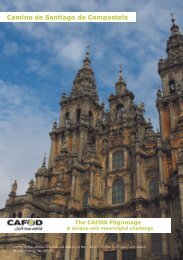Religious Education Curriculum Directory (3-19) - The Catholic ...
Religious Education Curriculum Directory (3-19) - The Catholic ...
Religious Education Curriculum Directory (3-19) - The Catholic ...
- No tags were found...
You also want an ePaper? Increase the reach of your titles
YUMPU automatically turns print PDFs into web optimized ePapers that Google loves.
<strong>Catholic</strong> Bishops’ Conference of England and Wales — Department of <strong>Catholic</strong> <strong>Education</strong> and Formation3.6. PRAYERPupils will experience Prayer as a living relationship with God, in and through Jesus Christ. It is anintimate encounter within the heart of each person. All forms of prayer, public and private are God’sgift, the action of the Holy Spirit in us and an expression of this living relationship. Prayer is an expressionof the universal search for God and the response of faith to God’s Self-Revelation. Consequently,pupils will be offered opportunities to participate in prayer and worship meaningfullysuited to their age and stage.3.6.1. What is prayer? (2559-2565)A <strong>The</strong> Church at prayera Liturgical year (1163-1178)b How we prayc Celebration of the Christian mysteries (1273,1389)d Sacramentals (1667-1679)e Popular piety (1674)f Christian funerals (1680-1690)g Indulgences (1471-1479)3.6.2. A universal call (2566-2567)A God calls every individual to a vital relationshipwith him experienced in prayer (2558)B Developing intimacy and communion with JesusChrist through prayer is an essential aspect in thelife of a believer or disciple (CT, no. 5; GDC, no. 80;)C Scripture is a source and guide for prayer (2567-2589, 2653-2654)a Scripture is a source, in that many prayerscome out of the Bible or are partly based onScriptural passages or events: Mass prayersand dialogues, psalms and canticles, Our Father,Hail Mary, Angelus (2673-2679)b Scripture is a guide, in that it gives us modelsof praying in biblical figures and teaches usabout prayerc Lectio divina is a way of praying on the Wordof GodD Expressions of prayer can be vocal, meditative, orcontemplative (2700-2724)E <strong>The</strong> forms of prayer are blessing, adoration, petition,intercession, thanksgiving, and praise (2626-2649)F Prayer requires effort and commitment (2729-2745)G <strong>The</strong> Lord’s Prayer forms a basis for the Church’sunderstanding of the value of prayer (2759-2865)3.6.3. Prayer in Judaism and other religions (NA1-3, 1096)A A better knowledge of the Jewish people’s faithand religious life as professed and lived even nowcan help us better understand certain aspects ofChristian liturgy (1096)B God has always called all people to prayer (2569)3.7. CELEBRATION: APOLOGETICS3.7.1. Can’t a person reach God directly withoutthe help of the Church or a priest (1538-1539)?A Any person can always pray directly to God. However,God established the Church as a way for himto teach us and to enrich us with his grace. JesusChrist gave us the Church and the sacraments forour salvation (774-776).B Sacraments provide an encounter with Christwhich is unique and graced (1076).C Sacraments celebrate and strengthen our unityand identity (774).3.7.2. Why do we need the Sacrament of Reconciliationto be forgiven (1434, 1440-1445)?A While God can forgive us however and wheneverhe wants, he knows what is best for us and hastaught us through Jesus that he wants to forgiveus through the Sacrament of Penance and Reconciliation(Jn 20:21-23; 1421, 1442)B <strong>The</strong> Sacrament of Reconciliation is necessary toforgive grave or mortal sins (1468), but it is not essentialfor the forgiveness of venial sins (1493)C People need to confess sins to face the reality ofthe wrong they have done, and in and through39
















